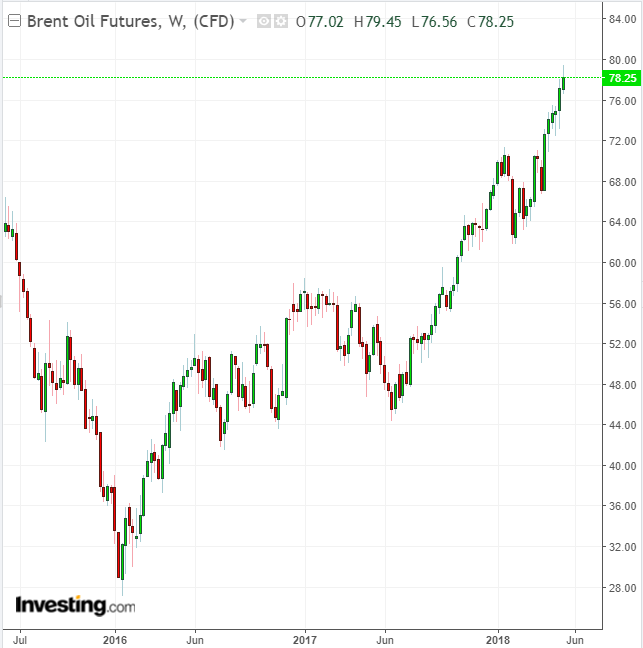With the price of Brent pushing toward $80 per barrel, market watchers are beginning to wonder if there is anything that can stop rising oil prices this spring. This is a far cry from last spring and summer when Brent prices barely broke the $55 per barrel mark. Now, Bank of America is even talking about seeing oil prices rise to $100 per barrel.

There are three major factors influencing rising prices right now:
- US President Donald Trump’s decision to reinstate sanctions on Iran
- The collapse of Venezuela’s oil industry and
- The OPEC/Non-OPEC production cut agreement
1. Iranian Sanctions
Even though it's not clear whether the countries and companies that have been purchasing, transporting and insuring Iranian oil will all comply with US sanctions, many are taking the Trump administration seriously and have begun requesting exemptions or discussions for alternative sources of oil.
The CEO of ENI (MI:ENI), the Italian oil company, expressed dissatisfaction with President Trump’s decision to pull out of the Iran deal. However, he clarified that even though ENI had been in talks to potentially develop oil and gas fields in Iran, it currently has no interests there and does not plan on making any investments in Iran. Notably, the CEO said ENI was not interested in investing in Iranian energy development because of unfavorable terms offered by Iran, not because of President Trump’s decision to reinstate sanctions.
Uncertainty over the fate of Iranian oil exports continues to push oil prices up. The biggest player in Iranian oil imports is China, which is responsible for about 24% of Iran’s total oil exports.
We are likely to see some sort of negotiation going on between the US and China to try to push the Chinese to reduce their Iranian oil imports. If the Trump administration succeeds in convincing China to reduce its imports of Iranian oil then we can expect oil prices to trend higher. If China continues to import Iranian oil at the same rate—or increases the amount it imports from Iran—then oil prices may start to trend downward as the price premium from the Iran deal announcement fades.
2. Collapse of Venezuela's Oil Industry
The impact of Venezuela’s collapsing oil industry cannot be overstated. During the past week ConocoPhillips (NYSE:COP) successfully expropriated Venezuelan oil in the Caribbean through a legal judgment to pay a debt, PDVSA abandoned the Isla refinery in Curacao and Venezuela purchased crude oil on the market to exchange with Cuba for goods. These are all further signs of the continuing collapse of Venezuela’s entire oil industry. The crisis will likely be reflected in further production declines in coming months.
3. OPEC/Non-OPEC Production Caps
The OPEC/Non-OPEC production cut agreement continues to support higher oil prices. Although Saudi Arabia has indicated that it intends to increase production to prevent market dislocation that could be caused by geopolitical events in Iran and Venezuela, Saudi Arabia has not yet made any actual moves. It seems that the market will have to wait for official word from OPEC when the organization meets in a little over a month.
Possible Constraints on Rising Prices
There are some signs that could stop, or at least slow, climbing oil prices. One of these is Mexico’s annual oil hedging process. The price point for these hedges is not yet known, but the process increases market volatility and has been known to cause sharp declines in the price of oil in the past.
US shale oil production is another wildcard. Production levels have exceeded predictions, but prices are still up.
On the other hand, limits on infrastructure and personnel in shale oil areas may be forcing some producers to sell oil at a discount. In fact, the WTI-Brent spread reached $8 per barrel on Tuesday, a three year high.
Although more North American pipelines are being built, until they come online, WTI will continue to be sold at significant discounts and this will constrain rising WTI prices.
